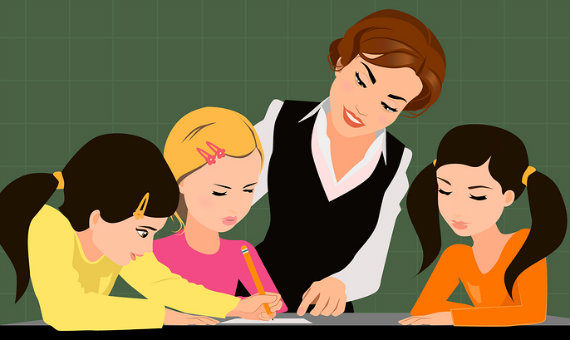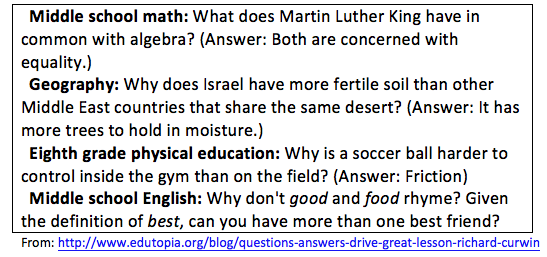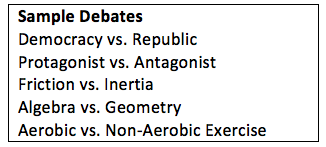Put Some Bang at the Beginning of Lessons

How we start out lessons in our classrooms makes a huge difference in the learning that takes place during the remaining minutes of instruction.
There are three keys to launching effective lessons. These are steps most of us have been taught, but in the daily rush to plan we may sometimes let one or more of them slip by. Here’s a refresher!
● Focus
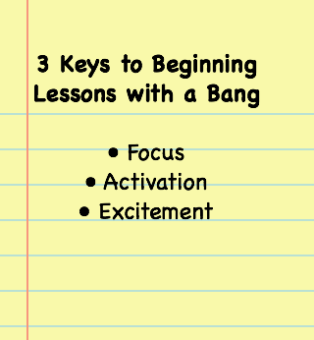
I’m regularly in classrooms where students begin class by copying a standard that is written on the board or projected on a screen or whiteboard. Although often required, this is not necessarily effective, especially when it becomes a rote activity. Students are copying, not comprehending.
There are several adaptations of this concept that can improve a student’s focus. First, teachers can change the standard to an “I Will” statement, encouraging students to think about what they will do by the end of the class. This shifts ownership to students and focuses on their performance to demonstrate understanding.
Another option is to turn the standard into a question to be explored. In this case, rather than your telling students what they will learn, they will set out to discover the answer to the question, once again shifting ownership to the student. Using questions is my preference, partly because questions activate the brain in a way that statements do not.
● Activation
The second characteristic of beginning an effective lesson is activating any background knowledge your students may have.
One of the keys to helping students learn is to make sure they build a strong base for new information. To effectively teach students something new, we need to know what they already know or think they know about a particular concept. In some instances they have knowledge that is incorrect, and we need to address their misconceptions in a way that leads them to understand the concept correctly.
Sticky Notes
Teacher Missy Miles describes a creative strategy for assessing background knowledge:
“As students come into class I hand each of them their own sticky note (which they love). I have a question or other directions written on the board that ask the students to tell me what they know about the topic we are beginning that day in class.
For example, ‘List five things you already know about William Shakespeare’ or ‘What do you know about the Holocaust?’ The students respond to the statement or question on their sticky notes and then place their notes on the board.
After all students have responded, I read each of the sticky notes out loud, often times categorizing their responses by grouping them on the board. By verbally acknowledging each sticky note, all students feel as though they have contributed to the ‘background knowledge board.’
Most important, many students realize they know more about the topic than they first thought as their memories are sparked by other students’ responses. I hear whispers in the class such as ‘Oh, yeah,’ or ‘I knew that!’ This strategy causes students to feel as though they can be successful at learning this subject because they already know something about it.”
Sharing What We Know
At times, Missy asks her students to work in small groups to write facts about a particular topic. As a sheet of paper comes around, students write one thing they already know and then pass it to their neighbor. The paper continues around the circle. When it comes around a second time, students can add an additional fact, making sure not to repeat anything that another group member has already stated.
This continues until the group has exhausted all thoughts on the subject. Next, switch papers among the groups and ask them to read another group’s list and see whether there’s anything they can add to it. As you facilitate, you can see how much shared learning is going on. As Missy explained, “More than likely, they’ll see something on the other group’s list they hadn’t thought of or didn’t know.”
● Excitement
Finally, you want to start your lessons with an exciting activity that immediately engages students. When I began teaching, I started each lesson with a “Do Now” or some type of written work students could do independently while I took care of attendance. My students were bored, and by the time the lesson started, they simply weren’t ready to learn. Let’s look at some more energizing ways to begin your lessons.
First, for the topic you will be teaching, create a webpage or blog entry that mimics an online encyclopedia entry. Include at least four content errors. Ask students to compare your web content to a credible reference site, such as National Geographic. Their task is to correct the mistakes. This is a great way to build some prior knowledge and hone students’ analysis skills.
Or, you can begin the lesson with a question to prompt their thinking. Dr. Richard Curwin shares a variety of questions to begin your instruction.
Another option is to begin the class with quick debates (five minutes or less). Perhaps today’s social studies lesson requires students to analyze multiple perspectives. Or you want your ELA students to compare main characters from two stories. Let’s set the foundation by allowing students to debate two sides of an issue.
They might debate which is better among two music choices, video services, or products. Perhaps the issue is whether IPhones are better than Androids. The topic itself might relate to your lesson but it doesn’t have to. You are charging up their learning brains and teaching students how to look at things from different points of view.
A Final Note
As you plan your lesson, remember to start with a bang. Do something that immediately helps students focus, then quickly establish some background knowledge, and start with an exciting activity that will ensure your learners are ready to go!
_________________________
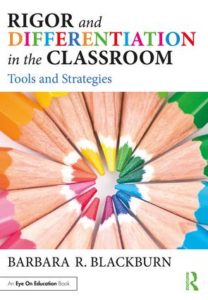
A nationally recognized expert in the areas of rigor and motivation, she collaborates with schools and districts for professional development. Barbara can be reached through her website or her blog. Follow her on Twitter @BarbBlackburn.

